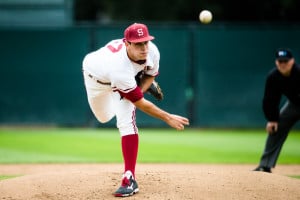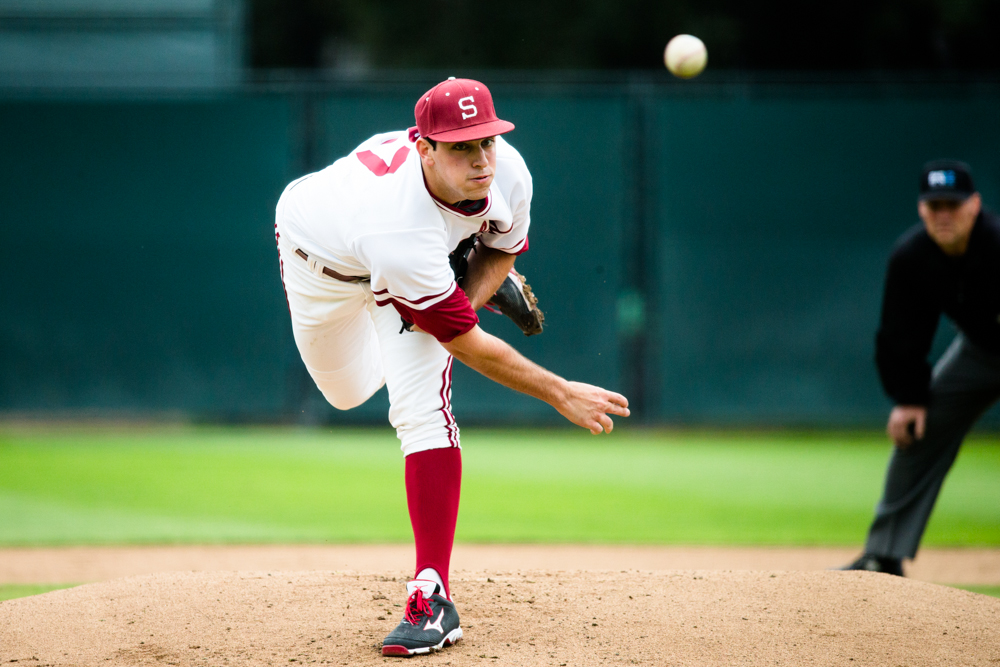When Stanford baseball head coach Mark Marquess last started a freshman pitcher on Opening Day, the Soviet Union still existed, Electronic Arts remained months away from releasing its first version of the Madden Football video game and none of the players on Stanford baseball’s current roster had been born.
Future five-time MLB All-Star Mike Mussina took the mound on that day for Stanford as a freshman in 1988, a year in which Stanford would eventually win the national championship. From 1989 to 2013, sophomores, juniors and seniors manned the starting pitcher’s role on Opening Day, but never a freshman. In the first 37 years of Marquess’ reign, freshmen pitchers had never even started the first three games of the season.

Consider that streak completely obliterated.
This season, Stanford has deployed four freshmen pitchers that have started the first twelve games for the Cardinal — a streak that has covered every game so far this season and doesn’t appear to be ending anytime soon.
Freshman pitchers Cal Quantrill, Brett Hanewich, Chris Viall and Tyler Thorne compose a four-man rotation that has made all 12 starts, compiling a combined 4-4 record with a 4.01 ERA in 55.2 innings pitched. Thorne has also made four appearances out of the bullpen and has assumed a mix of a spot starter’s and a reliever’s role with Quantrill, Hanewich and Viall having made all of the weekend starts.
“Everyone that I’ve talked to always said the same thing, that ‘freshman barely play, you’ll be lucky to play as a freshman,’” Hanewich said. “That says a lot about our pitching staff. We’re young but we’re also really talented.”
It is likely that that what the Cardinal has done is completely unprecedented in college baseball. No team other than Stanford started freshman pitchers in each of its first two games this season — much less every game. The rarity of freshman pitchers breaking into the rotation made that first moment on the mound even more special and memorable for each of the freshmen.
“It was pretty exciting, a dream come true,” said Quantrill of his first start, which came on Opening Day against Rice. “I spent my whole high school career looking forward to that moment when I’d first get to pitch. Most people go into college as freshman and get a chance at the ‘pen if they do a good job. Three of us got an opportunity right out of the gate on opening weekend to get a chance to start. It’s a blessing, I’m very thankful for the opportunity and hopefully we can make it work this year.”
However, the immediate transition between pitching in high school and pitching in college didn’t go exactly as expected — at least right away — for each of the freshmen. The first five starts of the season resulted in 14 earned runs allowed in 20.2 innings pitched for a combined 6.10 ERA.
“I had a very quick realization that pitching in college is much more based on hitting spots and making sure that you control the ball within the zone rather than just pumping up and throwing as hard as you can to get strikes,” Viall said. “You can throw extremely hard but if you are not able to place it low and outside, low and inside or drop an off-speed pitch in for a strike, then you are not going to succeed at the collegiate level — at least not very much.”
After shaking off the early season jitters, the starting pitchers surrendered only 11 earned runs in 32.2 innings pitched over the most recent seven games of the season for a 3.03 ERA. Quantrill, Viall and Thorne each recorded their first collegiate victories during that span. Not to be outdone, Hanewich leads the three weekend starters with a 2.70 ERA despite not yet having picked up his first win.
“The past three weeks have flown by, but I can already see myself developing as a pitcher and I’m feeling a lot more confident when I go out there,” Hanewich said. “I’m pitching instead of trying to be a thrower and blow it by people.”
Each pitcher brings his unique talents and experiences to the starting rotation. Quantrill, who hails from Ontario, Canada, pitched three seasons with 18-under Team Canada, including appearances in two 18-under World Championships and a silver medal in the 2012 championship. Hanewich possesses not only talent on the mound but also talent with the bat — as a switch hitter, no less — after having played at third base for much of his high school career. The 6-foot-9 Viall throws a fastball that can top out at or just above 95 mph. In addition to having earned numerous high school awards, Thorne also won a bronze medal in the 2007 Little League World Series.
“Just because we have freshmen starters doesn’t mean we’re going to have a bad year from a pitching standpoint,” Hanewich said. “I think where we are right now, we’ve struggled a little bit but we’ve also learned a lot of things about ourselves, which is going to help us in the long run.”
The added experience for the freshmen stands to pay dividends for the Cardinal not only for the rest of the season, but also for the next several years. Due to MLB draft eligibility rules, collegiate baseball players cannot be drafted until they complete their junior year or they are 21 years old. Consequently, Stanford could potentially use the same starting rotation for the next three or even four years, producing the kind of experienced group that tends to be the foundation of championship-contending teams. But for now, the focus for the freshmen remains solely on continuing to perform well and validating Marquess’ decision to start them.
“I know my spot is never going to be set; it’s always going to be earned,” Hanewich said. “Every single time I go out there, I feel like I have somewhere to improve so that I can pitch another day.”
Contact Michael Peterson at mrpeters ‘at’ stanford.edu.
